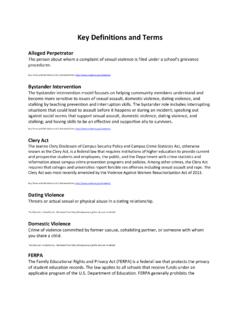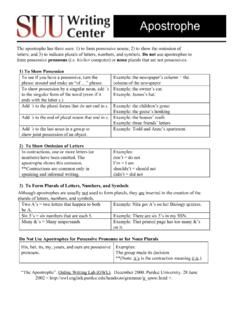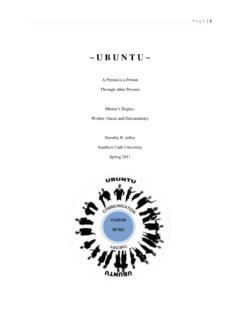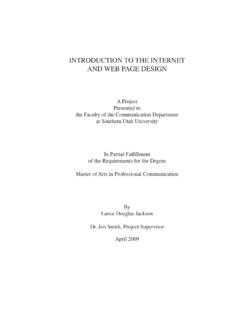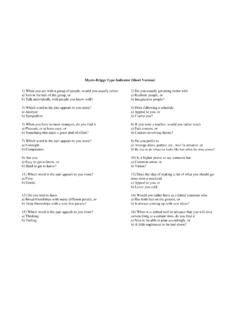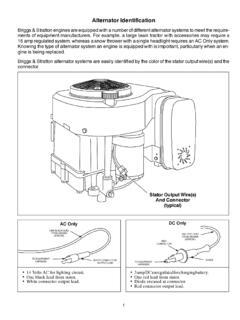Transcription of 128 Chapter 8 • Learning Styles and Teaching Styles
1 Learning Styles The questionnaire below is an informal indicator of your Learning style. Consider the Kolb Learning Style Inventory or the Myers- briggs Type indicator to learn about other aspects than those identified or for a more formal assessment Learning style is not a fixed or unchangeable. Learning Styles change and develop through exposure, instruction, or practice. For example, as you experience more college lectures, your skill as an auditory learner may be strengthened. People are not necessarily clearly strong or weak in each aspect. Some students learn equally well spatially or verbally. If there is very little difference between your two scores on one or more parts of the questionnaire, then you may have strengths in both areas. If, for some reason, you feel the description of yourself as a learner is incorrect, do not make changes in your Learning strategies based on the information.
2 Instead, discuss your style with a study skills instructor or counselor, or consider taking one of the tests listed above. Learning Style Questionnaire Select the alternative that best describes you. In cases in which neither choice suits you, select the one that is closer to your preference. Part One Your Answer 1. For a grade in biology lab, I would prefer to a. work with a lab partner. b. work alone. 2. When faced with a difficult personal problem, I prefer to a. discuss it with others. b. resolve it myself. 3. Many instructors could improve their classes by a. including more discussion and group activities. b. allowing students to work on their own more frequently. 4. When listening to a lecture or speaker, I respond more to a. the person presenting the ideas. b. the ideas themselves. 5. When on a team project, I prefer to a.
3 Work with several team members. b. divide up tasks and complete those assigned to me. 6. I prefer to shop and do errands a. with friends. b. by myself. 7. A job in a busy office is a. more appealing than working alone. b. less appealing than working alone. Totals Part One A _____ B _____ Part Two Your Answer 1. To solve a math problem, I would prefer to a. draw or visualize the problem. b. study a sample problem and use it as a model. 2. To remember things best, I a. create a mental picture. b. write it down. 3. Assembling a bicycle from a diagram would be a. easy. b. challenging. 4. I prefer classes in which I a. handle equipment or work with models. b. participate in a class discussion. 5. To understand and remember how a machine works, I would a. draw a diagram. b. write notes. 6. I enjoy a. drawing or working with my hands.
4 B. speaking, writing, and listening. 7. If I were trying to locate an office on an unfamiliar university campus, I would prefer a student to a. draw me a map. b. give me a set of written directions. Totals Part Two A _____ B _____ Part Three Your Answer 1. I prefer to a. learn facts and details. b. construct theories and ideas. 2. I would prefer a job involving a. following specific instructions. b. reading, writing, and analyzing. 3. I prefer to a. solve math problems using a formula. b. discover why the formula works. 4. I would prefer to write a term paper explaining a. how a process works. b. a theory. 5. I prefer tasks that require me to follow a. careful, detailed instructions. b. reasoning and critical analysis. 6. For a criminal justice course I would prefer to a. discover how and when a law can be used. b.
5 Learn how and why it became law. 7. To learn more about the operation of a high-speed computer printer, I would prefer to a. work with several types of printers. b. understand the principles on which they operate. Totals Part Three A _____ B _____ Part Four Your Answer 1. I would prefer to follow a set of a. oral directions. b. written directions. 2. I would prefer to a. attend a lecture given by a famous psychologist. b. read an article written by the psychologist. 3. I am better at remembering a. names. b. faces. 4. It is easier to learn new information using a. language (words). b. images (pictures). 5. I prefer classes in which the instructor a. lectures and answers questions. b. uses films and videos. 6. To obtain information about current events, I would prefer to a. listen to news on the radio. b. read the newspaper.
6 7. To learn how to operate a fax machine, I would a. listen to a friend s explanation. b. watch a demonstration. Totals Part Four A _____ B _____ Part Five Your Answer 1. To make decisions I rely on a. my experiences and gut feelings. b. facts and objective data. 2. To complete a task, I a. can use whatever is available to get the job done. b. must have everything I need at hand. 3. I prefer to express my ideas and feelings through a. music, song, or poetry. b. direct, concise language. 4. I prefer instructors who a. allow students to be guided by their own interests. b. make their expectations clear and explicit. 5. I tend to a. challenge and question what I hear and read. b. accept what I hear and read 6. I prefer a. essay exams. b. objective (multiple-choice, true-false) exams. 7. In completing an assignment I prefer to a.
7 Figure out my own approach. b. be told exactly what to do. Totals Part Five A _____ B _____ Scoring Grid In the scoring grid below, record the total number of choice A s and B s for each part of the questionnaire. Circle the word that corresponds to the higher number. The higher number indicates your dominant Learning Styles . Total Number of Choice A Total Number of Choice B Part One (Social) (Independent) Part Two (Spatial) (Verbal) Part Three (Applied) (Conceptual) Part Four (Auditory) (Visual) Part Five (Creative) (Pragmatic) Interpreting Your Scores The questionnaire was divided into five parts; each part identifies one aspect of your Learning style. Each of these five aspects is explained below. Part One Social or Independent Learners This score reveals your preferred level of interaction with other people in the Learning process.
8 If you are a social learner, you prefer to work with others both peers and instructors closely and directly. Social learners tend to be people-oriented and enjoy personal interaction. If you are an independent learner, you prefer to work and study alone. You tend to be self-directed or self-motivated, and you are often goal-oriented. Part Two Spatial or Verbal Learners This score reveals your ability to work with spatial relationships. Spatial learners are able to visualize or mentally see how things work or how they are positioned in space. Their strengths may include drawing, assembling things, or repairing. Verbal learners lack skills in positioning things in space. Instead they tend to rely on verbal or language skills. Part Three Applied or Conceptual Learners This score describes the types of Learning tasks and Learning situations you prefer and find easiest to handle.
9 If you are an applied learner, you prefer tasks that involve real objects and situations. Practical, real-life Learning situations are ideal for you. Examples will often make an idea clear and understandable. If you are a conceptual learner, you prefer to work with language and ideas; practical applications are not necessary for understanding. You may enjoy working with theories and concepts and tend to work from rule to example. Part Four Auditory or Visual Learners This score indicates through which sensory mode you prefer to process information. Auditory learners tend to learn more effectively through listening, while visual learners process information by seeing it in print or other visual modes including film, picture, or diagram. If you have a higher score on auditory than visual, you tend to be an auditory learner. That is, you tend to learn more easily by hearing than by reading.
10 A higher score in visual suggests strengths with visual modes of Learning . Part Five Creative or Pragmatic Learners This score describes the approach you prefer to take toward Learning tasks. Creative learners are imaginative and innovative. They prefer to learn through discovery or experimentation. They are comfortable taking risks and following hunches. Pragmatic learners are practical, logical, and systematic. They seek order and are comfortable following rules. Learning Strategies for Various Learning Styles Social 1. Interact with instructor. 2. Find a study partner. 3. Form a study group. 4. Take courses involving class discussion. 5. Work with a tutor. Independent 1. Use computer-assisted instructions if available. 2. Enroll in courses using traditional lecture-exam format. 3. Consider independent study courses.



